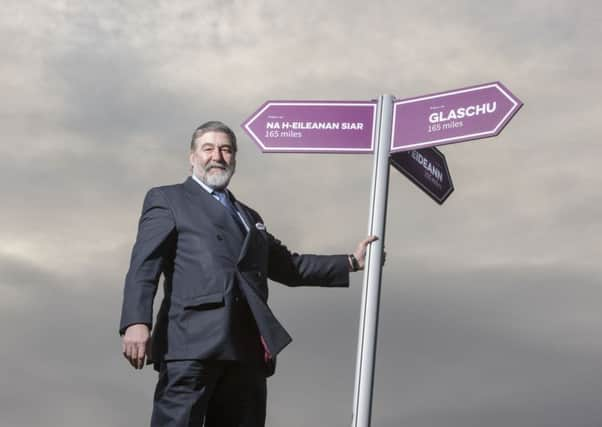Experiencing a Gaelic welcome when visiting Scotland


Scotland’s Experiencing Gaelic is a newly-developed Welcome Scheme and was launched by John Thurso, Chairman of VisitScotland.
VisitScotland is working in partnership with The Highland Council and Highlands and Islands Enterprise to deliver this year’s conference.
Advertisement
Hide AdAdvertisement
Hide AdMore than 180 delegates had the opportunity to attend breakout sessions on the topics of Slow Adventure Tourism, VisitScotland’s iKnow Scotland Programme, Year of History, Heritage and Archaeology, Business Gateway support and Marine Tourism.
Recent research show that over half the visitors to Scotland are interested in learning more about the Gaelic language, heritage, culture and traditions.
VisitScotland has developed the Experiencing Gaelic scheme to recognise those businesses that excel in meeting the expectations of visitors who are interested in learning more about this native language, including all accommodation sectors, cafes, restaurants and visitor attractions.
The Experiencing Gaelic scheme is not just about speaking Gaelic but it encourages businesses to spend time researching their local area, providing translations and offering links to local Gaelic heritage centres and places of interest.
Advertisement
Hide AdAdvertisement
Hide AdVisitScotland is encouraging businesses to offer details of traditional music events and festivals, make Gaelic TV and radio available, and offer opportunities to practice a bit of the language, and provide some story books in Gaelic with English translations for the younger, and even older, generations.
Highland and Islands Enterprise (HIE) is also currently working on an industry toolkit, entitled Gaelic and Scots Language.
This will be an online resource for industry detailing the business opportunities in embracing our Gaelic and Scots culture, heritage and traditions.
Scotland’s Year of History, Heritage and Archaeology 2017 was launched last month and with the Highlands’ world-class history, resources, unique attractions and passionate and knowledgeable industry, next year poses fantastic opportunities for the region.
Advertisement
Hide AdAdvertisement
Hide AdAt the conference, delegates found out ways to engage in this themed year in a dedicated workshop.
Tourism Secretary Fiona Hyslop said: “Gaelic is an integral part of Scottish culture. Tourists will come across Gaelic names all across Scotland, in our towns and cities and rural areas with lochs, mountains and rivers that are still using the original Gaelic description.
“VisitScotland’s Experiencing Gaelic Welcome Scheme will see tourism businesses providing links to heritage centres and places of interests for visitors with an interest in our Gaelic heritage. This initiative recognises the cultural, economic and social value of the language to our whole country.”
John Thurso, Chairman of VisitScotland, said: “I am delighted to be attending the Highland Tourism Conference and to be launching our new Experiencing Gaelic scheme today.
Advertisement
Hide AdAdvertisement
Hide Ad“For many visitors, it is an interest in the Gaelic language and culture that drives them to visit establishments in this scheme and not necessarily that they speak Gaelic to any degree. Scotland’s many place names, mountains, rivers and natural features are often created and written in Gaelic, such as Cairngorm (the blue or green mountain).
“To give our non-Gaelic speakers a translation of these names would capture the spirit of the area, bringing it to life and giving a sense of place, which will enhance their experience of Scotland and, in turn, their understanding of Gaelic.”
He added: “It has been very encouraging to see so many individuals and businesses involved at this year’s conference, all keen to work together, and learn how they can attract even more visitors to Scotland.”